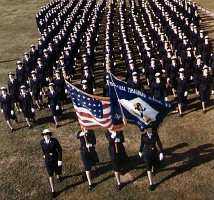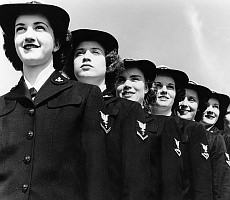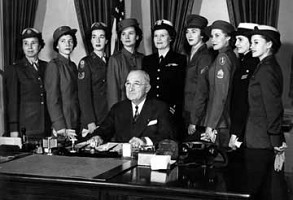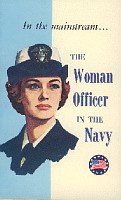Strength of the WAVES
.
| The WAVES were created in 1942 and their personnel
strength increased rapidly throughout the year. As of July 1943, some 27,000
officers and enlisted women were on duty in the naval service, but nearly
10,000 were still undergoing training in various programs.
At that time, the ratio of officers to enlisted
women was about one to five. By the beginning of 1944, the number of WAVES
reached 72,350 women. The most sizeable group of enlisted women comprised
24,500 seamen. Another 13,000 enlisted WAVES were absorbed by the Hospital
Corps. |
.. |
 Schools trainees at the
U.S. Naval Training Center, Women's Reserve, The Bronx, New York
Schools trainees at the
U.S. Naval Training Center, Women's Reserve, The Bronx, New York
|
Shortly before the end of World War II, in
early August 1945, the WAVES reached their peak strength. At that time,
the WAVES were comprised of 8,000 female officers and 78,000 enlisted women
on active duty.
.
 WAVES Petty Officers
WAVES Petty Officers
|
.. |
This number represented 18 percent of all
naval personnel assigned to shore establishments in the stateside United
States, being based in over 900 stations and bases directly serving the
fleet and forward bases throughout the Pacific.
This large number of WAVES effectively released
over 50,500 male sailors for duty either aboard ships or in other forward
positions overseas. In addition to this achievement, the WAVES became responsible
for nearly 27,000 other newly created jobs. |
.
Postwar WAVES
.
The wartime performance of the WAVES had been
so successful that the Navy was reluctant to give up the program, which
had been planned as an experimental war-emergency measure. Therefore, although
the Navy rapidly demobilized and returned to peacetime strength, a small
nucleus of officer and enlisted women were retained on active duty. On
March 27, 1946, the Navy suggested that Congress consider making their
retention permanent, by authorizing the enlistment and appointment of women
in the regular Navy and in the Naval Reserve. By that time, the number
of WAVES on active duty had been reduced to 9,800 female personnel.
.
Legislation to integrate women into the permanent
Navy structure was introduced in 1946 and passed by the Senate on July
23, 1947. However, Congress adjourned before final action on the bill was
taken. The number of WAVES continued to diminish and the active ranks of
women were reduced to only 2,300 personnel by January 1948.
.
| Congress again took up the issue, officially
known as the Women's Armed Services Integration Act. It was passed by the
Senate on May 26, 1948, and by the House of Representatives on June 2.
President Truman then approved and signed the legislation into law on June
12, 1948. |
.... |
 |
.
For the first time, WAVES could now be appointed
and enlisted in the Regular Navy and Naval Reserve. This meant that the
former “Women's Reserve” was eliminated, and all female officers and enlisted
women were transferred to corresponding components of the Regular Navy
and Naval Reserve. The law also set an authorized strength of women in
the Regular Navy (two percent of the total Navy enlisted strength). The
number of authorized female commissioned and warrant officers was set at
ten percent of the number of enlisted women in the Navy. The law also set
a limit of 500 officers, 20 warrant officers and 6,000 enlisted women for
two years. The law also provided the same pay, leave conditions, monetary
allowances, and other benefits accorded Navy male personnel for women serving
in the Navy.
.
 |
.vv |
The Navy began implementing the new WAVES
program on June 13, 1948, when it authorized the enlistment of women reservists
in the Regular Navy. Shortly thereafter, on 7 July, 1948, the first group
of enlisted women was sworn into the Regular Navy, which marked a real
milestone of naval acceptance. On October 15, the first WAVE officers were
also sworn into the Regular Navy. That September, the Navy began recruiting
enlisted women again, and these first recruits reported to training at
Great Lakes, Illinois, during the next month. In December, the first class
of newly commissioned female officers accepted from civilian status was
sent to the new WAVES General Line School at Newport, Rhode Island. |
.
During 1949, women were again serving important
roles throughout the Navy. Some WAVES were posted overseas, and even saw
duty with the Navy contingent of the Berlin Airlift (despite dangerous
conditions flying over Soviet-held territory into the beleaguered former
German capital). By the end of July 1949, there were 3,216 WAVES serving
on active duty within the Navy.
.
.
[ I. Development ]..[
II. Facts about the WAVES ]..[
III. Uniforms ]..[
IV. Sources ]
|
